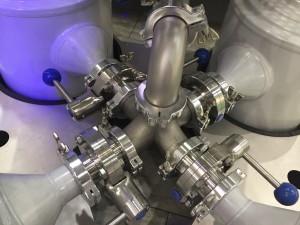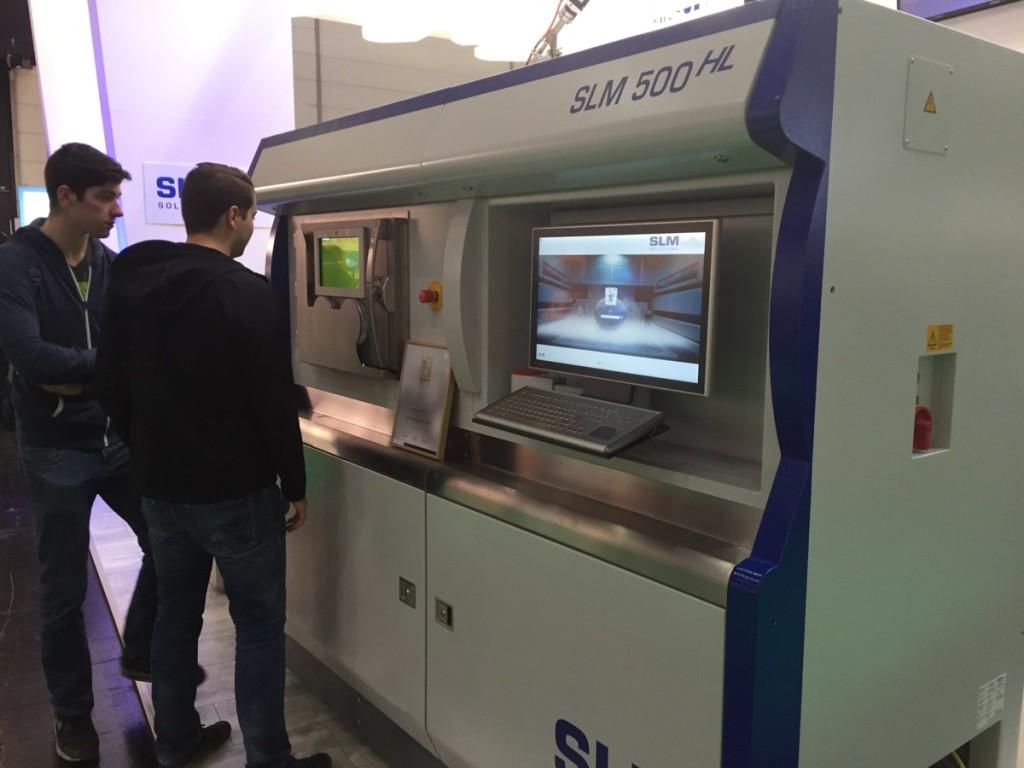Discovering the Four-Laser SLM 500 HL 3D Printer with SLM Solutions’ Director of Engineering
 There are not many powder bed fusion machines on the market that already offer multiple laser build capabilities. SLM Solutions’ SLM 500 HL builds parts using four 400-watt lasers working at the same time. The machine was on display at Inside 3D Printing Düsseldorf in February, and we did not miss the opportunity to speak with the company’s Director of Engineering and Product Management, Dr. Jan Wilkes, about how this wonder of advanced industrial technology does what it does.
There are not many powder bed fusion machines on the market that already offer multiple laser build capabilities. SLM Solutions’ SLM 500 HL builds parts using four 400-watt lasers working at the same time. The machine was on display at Inside 3D Printing Düsseldorf in February, and we did not miss the opportunity to speak with the company’s Director of Engineering and Product Management, Dr. Jan Wilkes, about how this wonder of advanced industrial technology does what it does.
Wilkes is the person in charge of all engineering groups involved in designing the machines and making sure they function correctly. These include the chemical, electric, hardware engineering, software development, process and material development teams, as well as a technology development group and product management group.
“The advantages of multiple lasers are evident in terms of speed in the build rate and productivity,” he immediately clarifies. “Having four lasers means you can reach productivity that is more than 3 times as fast as single laser machines, this is a very significant increment.”
 Exactly how much faster four lasers can work depends very much on part geometry, on whether it is a massive part or a thin wall part, and on the proportional scanning time. Furthermore, sometimes a part is not shaped in a way that it can be made with full uptime of all four lasers. In this case one of the lasers may pause and that would reduce the combined build rate. Nevertheless, with all parameters being optimal, the rate can get very close to a fourfold increment.
Exactly how much faster four lasers can work depends very much on part geometry, on whether it is a massive part or a thin wall part, and on the proportional scanning time. Furthermore, sometimes a part is not shaped in a way that it can be made with full uptime of all four lasers. In this case one of the lasers may pause and that would reduce the combined build rate. Nevertheless, with all parameters being optimal, the rate can get very close to a fourfold increment.
Wilkes is now working on powering up the lasers, which, in a way, is the same idea of using a bigger nozzle on filament-based machines. The machine currently works with four 400-watt energy sources, and the engineering team is studying an upgrade to four 700-watt lasers.
“Increasing the laser power is tricky and is not sufficient for incrementing speed,” Wilkes explains. “A more powerful laser increases the size of the meltpool and that generally means that the resolution and surface quality becomes poorer. You cannot just increase the laser power to 2, 3 or 5 KW without losing part quality. We found that we can manage 700 Watt and achieve approximately the same quality as 400 Watt lasers. Increased laser power is particularly beneficial to aluminum alloys.”
For example, says Wilkes, with a typical aluminum alloy you can increase scanning speed up to 100% compared to a 350-watt laser. However, he warns, you cannot push significantly beyond that: you cannot have 2 KW laser and still achieve the same quality. More lasers – even beyond four beams – is an alternative approach that SLM Solutions is going to look at in the future.
“It is not a principal difference in terms of algorithms when you use 4 or 8 lasers,” says Wilkes. “One thing that is particularly tricky in the multiple laser setup is the alignment of the lasers with each other. That’s because, if you are building a large part with all lasers in parallel, they have to be aligned with extreme precision.”
 The SLM 500 was the first double laser machine and is currently the only quadruple laser SLM 3D printer on the market; however, the recent improvements on the new SLM 500 HL have been focusing on other aspects that can speed up the production cycle – for example, by managing cooling more efficiently. The machine now features an exchangeable build platform concept. Once a build is complete, the entire build plate is ejected from the machine and the parts can cool down while the machine can begin working on a whole new set of parts. The plate moves right out of the machine and can subsequently be positioned inside the powder cleaning station.
The SLM 500 was the first double laser machine and is currently the only quadruple laser SLM 3D printer on the market; however, the recent improvements on the new SLM 500 HL have been focusing on other aspects that can speed up the production cycle – for example, by managing cooling more efficiently. The machine now features an exchangeable build platform concept. Once a build is complete, the entire build plate is ejected from the machine and the parts can cool down while the machine can begin working on a whole new set of parts. The plate moves right out of the machine and can subsequently be positioned inside the powder cleaning station.
As anticipated, the SLM 500 HL is now capable of 3D printing some of its own parts. Wilkes showed me one that is visible, and of course it looks just like any other part. He also said that some of the complex parts on the inside are built by SLM, which, of course, makes perfect sense. Machines building themselves and engineers optimizing every aspect of the production cycle: that is why the speed of metal 3D printing is increasing exponentially, doubling approximately every two years. Today we are talking about going from two to four lasers; one day we may be considering going from 128 to 256. SLM Solutions will probably have a solution for that too. Discuss your thoughts on this new technology in the SLM 500 HL 3D Printer forum over at 3DPB.com.
Subscribe to Our Email Newsletter
Stay up-to-date on all the latest news from the 3D printing industry and receive information and offers from third party vendors.
Print Services
You May Also Like
Low-cost “Suzy” Polymer Powder 3D Printer is Faster and Cheaper than Past Models
Polish laser powder bed fusion (LPBF) firm Sinterit has released a follow-up to its predecessors, Lisa and Nils, called Suzy, a $19,490 printer equipped with a 30W fiber diode laser....
India’s $58M Space Fund Is a Boon for AM Innovation
India’s space industry is picking up serious momentum. With a projected $44 billion space economy by 2033, the country is aggressively expanding its capabilities, fostering private-sector participation, and reducing its...
Japanese Advanced Manufacturing Capabilities Grow in Europe with Sodick’s Purchase of Prima Additive
The global economy is currently undergoing a reshuffling in terms of what gets manufactured where. In large part, this trend is being driven by new geopolitical alliances and the need...
Bosch Invests €6M into Serial Auto Part 3D Printing
German industrial conglomerate Robert Bosch GmbH, the world’s largest supplier of automotive parts, has announced a new investment into Nuremberg, Germany additive manufacturing (AM) facility. The nearly €6 million in...




























